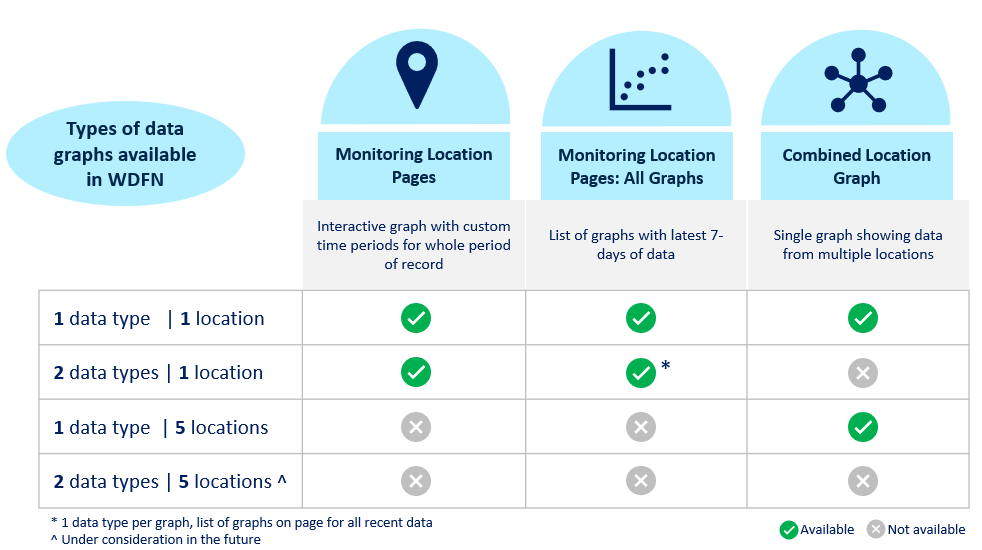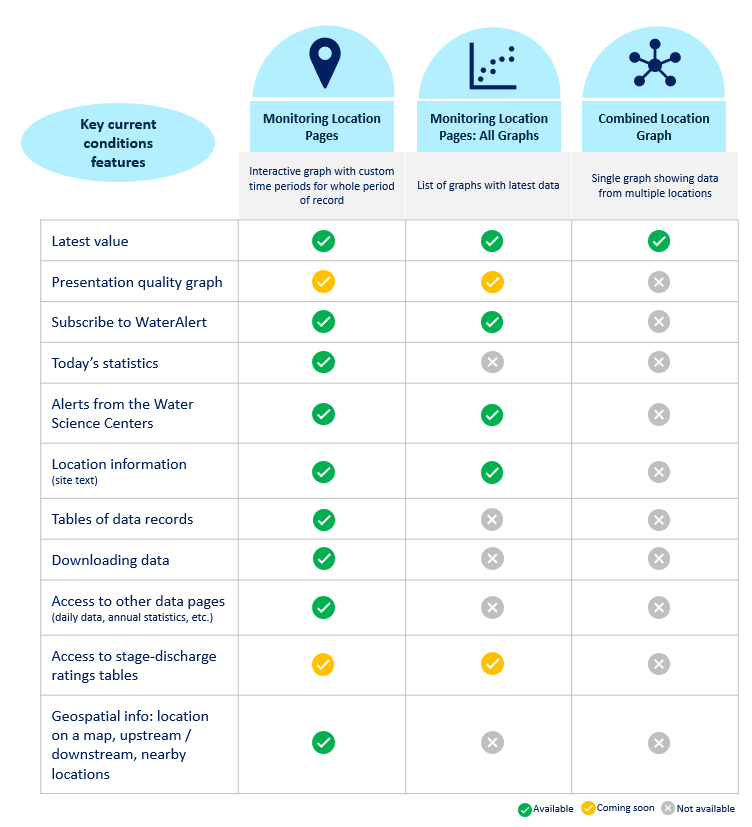Data Graphs in Water Data for the Nation
A look into the different data graphs available in WDFN
We have been hard at work designing how to view our water data on graphs in Water Data for the Nation (WDFN). Right now, the primary option is monitoring location pages which have a graph that can look at data over the entire period of record, but this year we’re introducing two additional options to view graphed data!
Where can I get my favorite data graphs?
In 2023, you will be able to access your favorite views of data on WDFN in several different pages:
- Monitoring Location Page : This page offers an interactive hydrograph that allows users to look at up to two types of data on one graph for a custom date period.
- All Graphs view of Monitoring Location Page : A new tool coming in Summer 2023 to see all the most recent data collected at one monitoring location, on one long webpage. This page allows users to look at all the data we’re monitoring with sensors, with each on its own graph allowing you to review recent conditions and status of a location at a glance without clicking.
- Combined Location Graph : A new tool coming in Summer 2023 to look at data from multiple monitoring locations all in one graph. Users specify the type of data they want to see and can compare it to that same data type at up to five other locations.
In 2023, WDFN will not include data graphs that show multiple data types at multiple locations on the same page. This is under consideration for future development.

Types of data graphs available in WDFN.
Where can I find the features I need?
The Monitoring Location Pages serve as a homepage for all the information you need about any place we collect data. This page offers site metadata, such as location and funding information, and access to data summaries. It is also where you plot and interact with recent or historical data and explore the different types of data that are collected at the location.
The Monitoring Location Pages: All Graphs is oriented more toward operational needs where users are monitoring the latest data as water events are occurring. When launched, All Graphs will feature a graph for every data type that has sensor data from the past 7 days for one location.
The Combined Location Graph page is where you can compare data from several monitoring locations, such as locations that are on the same river or to see how different streams or rivers were impacted by a recent storm. The graph shows a single data type from multiple locations, so you can simultaneously see the data from several locations you’re interested in.

Key current conditions features and how they map to WDFN features.
Which WDFN page is best for me?
Each user should determine which product is best for their needs. The Monitoring Location Pages serve as the main home for data and metadata at each location. It may serve you well as your bookmarked entry point to WDFN to access all the related content. This page serves to help you:
- Learn more about the location
- Graph historical data
- Summarize data records and metadata
- Easy access to related graphs and tables: such as All Graphs, Combined Location Graph, and legacy data views
While the Monitoring Location Pages hold a lot of different details about locations, it may not work well if you need fast access to the latest data. In that case, Monitoring Location Pages: All Graphs may be a better fit. All Graphs serves to help you:
- Graph the latest data
- See the latest info from the Water Science Center
- Provides the easiest transition from legacy, as it looks and feels most similar to legacy current conditions
When interesting water events are occurring, it can be helpful to look at several locations’ data together. If you have a set of related locations you are interested in, Combined Location Graph can be configured with your locations and bookmarked for easy access when the next water event occurs. Combined Location Graph serves to help you:
- Compare latest data for several locations
Many of you may find that your needs change over the year, which is why we have provided easy access to these different graphs from the Monitoring Location Pages under a button called “View related graphs”.

View related graphs on the Monitoring Location Page to access Combined Location Graph and All Graphs.
What’s next?
The Monitoring Location Pages: All Graphs and Combined Location Graph pages are currently in beta while we collect information on how they are working for users. Our team uses user-centered design processes to determine what to prioritize next. Let us know how the pages are working for you by emailing wdfn@usgs.gov .
Related Posts
New Feature - SensorThings API
August 3, 2023
SensorThings coming soon to WDFN. Use the SensorThings API to access national-scale data for quicker application development and the ability to map those results. This API provides users with a flexible way to interconnect data, devices, and application over the Web.
New Feature - All Graphs
June 6, 2023
We are excited to announce that a new feature is now available to Monitoring Location Pages as part of our modernization efforts. The All Graphs page will show a series of individual graphs of all current sensor data collected at a single location.
New Feature - Explore USGS Water Data
June 6, 2023
Locating and filtering data by specific parameters is coming soon! Explore USGS Water Data provides users with a dynamic tool to customize and throttle targeted information to meet the needs of users.
New Feature - Combined Location Graphs
April 19, 2023
Graphing data for multiple locations on a single graph is here! As part of our modernization effort, we are happy to announce a new page from Water Data for the Nation.
Water Data for the Nation in 2023
April 19, 2023
What is Water Data for the Nation? Water Data for the Nation (WDFN) is the home for USGS’s modernization of public delivery of water data. USGS water data can be accessed by the public in many ways:

